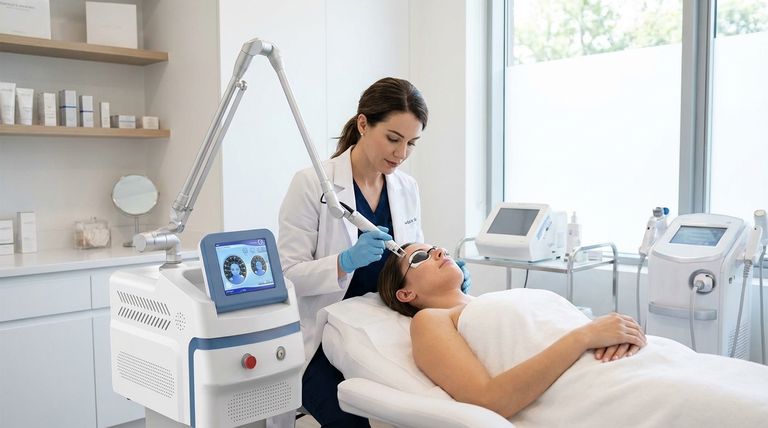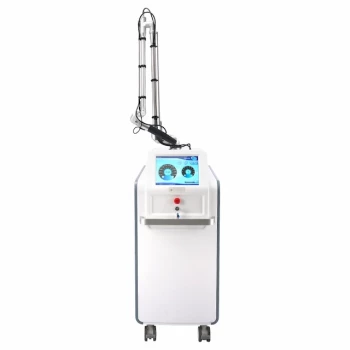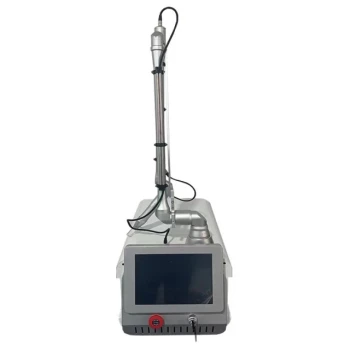Pico laser technology is a non-invasive treatment designed to correct common skin imperfections. It is highly effective for addressing issues like unwanted pigmentation from sun damage and textural irregularities like acne scarring. It is widely considered one of the most significant advancements in dermatological laser treatments due to its unique mechanism of action.
Unlike older laser technologies that use intense heat, Pico lasers deliver ultra-short energy pulses measured in picoseconds. This creates a photomechanical impact that shatters target pigment and stimulates collagen without significantly damaging surrounding tissue, resulting in greater precision and often a more manageable recovery.

How Pico Lasers Fundamentally Work
To understand what a Pico laser does, you must first understand how it differs from traditional lasers. The innovation is not just the laser itself, but the speed at which it delivers energy.
The Power of the Picosecond
A picosecond is one trillionth of a second. Pico lasers deliver energy in these incredibly short bursts.
This rapid energy delivery doesn't primarily heat the skin. Instead, it creates a powerful photomechanical or photoacoustic effect—essentially a tiny, targeted pressure wave.
Photomechanical vs. Photothermal Effect
Older lasers, like nanosecond lasers, operate on a photothermal principle. They deliver energy more slowly, which heats the target (like pigment) and the surrounding tissue. This can be effective but often leads to more collateral damage and longer downtime.
Pico lasers use a photomechanical effect. The intense pressure wave mechanically shatters the target, such as a pigment particle or tattoo ink, into minuscule dust-like particles. Imagine trying to break a rock: a photothermal laser is like a blowtorch slowly melting it, while a Pico laser is like a high-frequency shockwave that shatters it instantly.
Stimulating Collagen and Elastin
This intense mechanical stress delivered to the dermal layer also triggers the body's natural healing response.
This process signals the body to produce new collagen and elastin—the essential proteins that give skin its structure, firmness, and elasticity. This is why Pico treatments are also used for overall skin rejuvenation.
Key Applications and Benefits
The unique mechanism of Pico lasers makes them highly versatile for treating some of the most common and stubborn skin concerns.
Targeting Unwanted Pigmentation
This is the primary use for Pico technology. It is exceptionally effective at shattering pigment from sun spots, age spots (lentigines), and freckles.
The shattered pigment particles are then small enough for the body's lymphatic system to naturally clear away over the following weeks, leading to a clearer complexion.
Improving Acne Scars and Texture
For atrophic (depressed) acne scars, the collagen-stimulating effect is key. The Pico laser can be used with a specialized fractional lens to create micro-injuries in the dermis.
As the skin heals, new collagen helps to "fill in" the depressions from beneath, smoothing the skin's surface and improving overall texture. This same process can help reduce the appearance of fine lines and enlarged pores.
Removing Tattoos
The photomechanical effect is the gold standard for tattoo removal. It is incredibly efficient at shattering ink particles of various colors, including stubborn blues and greens, which were historically difficult to treat.
Understanding the Trade-offs and Considerations
No treatment is a magic bullet. Objectivity requires acknowledging the limitations and potential risks associated with Pico lasers.
Not a One-and-Done Solution
Achieving desired results almost always requires a series of treatments. The number of sessions can range from 3 to 6 or more, spaced several weeks apart, depending on the severity of the condition being treated.
Potential Side Effects
Common and temporary side effects include redness, mild swelling, and pinpoint bleeding, which typically resolve within hours to a few days.
A more significant risk, particularly for individuals with darker skin tones, is post-inflammatory hyperpigmentation (PIH), where the treated area becomes darker. While Pico lasers generally have a lower risk of PIH than older lasers, the risk is not zero.
The Importance of the Practitioner
The results and safety of a Pico laser treatment are highly dependent on the skill of the operator. The device's settings must be precisely calibrated for your skin type and specific concern. Always seek treatment from a board-certified dermatologist or a highly experienced, certified technician working under medical supervision.
Making the Right Choice for Your Goal
Pico laser is a powerful tool, but its suitability depends entirely on your specific objective.
- If your primary focus is stubborn pigmentation or sun damage: Pico lasers offer a precise way to shatter pigment with less thermal damage and downtime compared to many older technologies.
- If your primary focus is acne scarring and skin texture: The treatment's ability to stimulate collagen remodeling can significantly improve skin smoothness and reduce the appearance of scars over a series of sessions.
- If you are considering tattoo removal: Pico technology is a leading standard, particularly effective at breaking down a wide spectrum of ink colors that were once difficult to treat.
Understanding the underlying mechanism of Pico technology empowers you to have a more informed discussion with a qualified practitioner about achieving your specific skin goals.
Summary Table:
| Key Benefit | How Pico Laser Achieves It |
|---|---|
| Targets Pigmentation | Shatters sun spots & age spots via photomechanical effect for natural clearance. |
| Improves Skin Texture | Stimulates collagen to fill in acne scars and smooth fine lines. |
| Removes Tattoos | Effectively breaks down stubborn ink particles of various colors. |
| Minimizes Downtime | Ultra-short pulses reduce thermal damage to surrounding tissue. |
Ready to transform your clients' skin with advanced Pico laser technology?
BELIS specializes in providing professional medical aesthetic equipment to clinics and premium beauty salons. Our Pico laser systems are designed to deliver the precision and results your practice demands, helping you offer cutting-edge treatments for pigmentation, scarring, and rejuvenation.
Contact our experts today to learn how our technology can enhance your service offerings and drive your business growth.
Visual Guide

Related Products
- Pico Picosecond Laser Machine for Tattoo Removal Picosure Pico Laser
- Pico Laser Tattoo Removal Machine Picosure Picosecond Laser Machine
- Q Switch Nd Yag Laser Machine Tattoo Removal Nd Yag Machine
- Clinic Use IPL and SHR Hair Removal Machine with Nd Yag Laser Tattoo Removal
- Diode Laser SHR Trilaser Hair Removal Machine for Clinic Use
People Also Ask
- What are the downsides of Pico laser? Understanding the Risks for Safe Treatment
- What is the disadvantage of Pico laser treatment? Understand the Risks and Costs Before You Decide
- How many sessions of Pico laser do you need to see results? A Realistic Timeline for Your Skin Goals
- How does Pico work? Harnessing Ultra-Fast Light for Precise Skin Treatments
- How much should a Pico laser cost? A Clear Breakdown of Pricing Factors



















